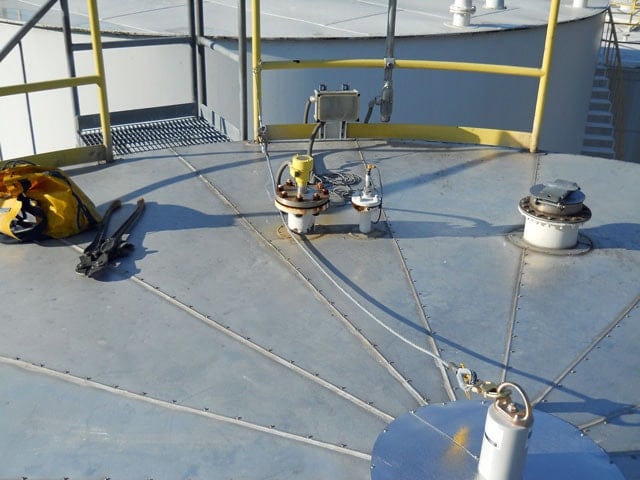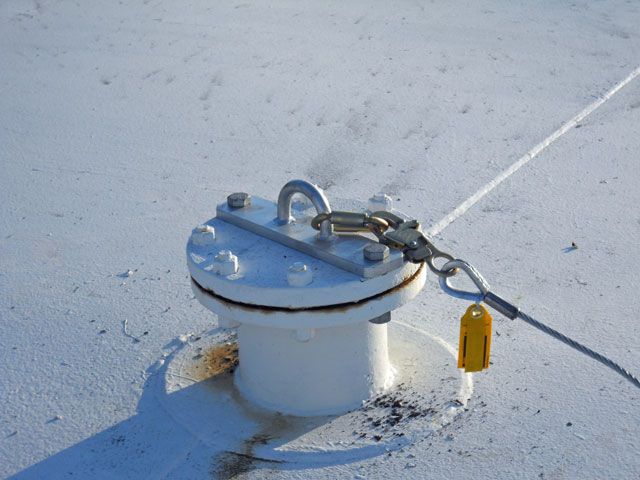Fall Protection Systems for Chemical, Petrochemical, and Refinery Towers and Silos
Silos and towers used in the chemical, petrochemical and refinery industries present a number of fall protection and confined space hazards to personnel charged with their maintenance, inspection, and repair. Workers climbing from the ground level to access monitoring instrumentation and loading equipment located at the top of the silo or tower and personnel charged with performing maintenance inside the storage area require comprehensive fall protection and confined space and rescue systems. Partnering with a fall protection company that understands the fall hazards and confined space issues presented by silos and towers used by your industry is vital to keeping your employees safe and your facility in compliance with all OSHA safety regulations.

Silo and Tower Fall Protection

Silo and Tower Fall Protection
We are a complete turnkey provider of fall protection systems designed for silos and towers for chemical, petrochemical, and refinery applications and have the years of design and installation experience in this market sector. Contact us for expert assistance with your fall arrest, fall restraint and fall protection requirements.
Fall Protection Solutions
-
Guardrail
View Guardrail -
Horizontal Lifelines
View Horizontal Lifelines -
Rescue and Descent Systems
View Rescue and Descent Systems -
Tip-Over Single Point Anchors
View Tip-Over Single Point Anchors
Design Considerations
The vertical storage characteristics of industrial silos and bulk storage towers can lead to the build-up of pressure and heat, which left unchecked, may result in an explosion. Silos and towers utilize fans and related equipment designed to keep the stored material from settling. Maintenance personnel use ladder systems to monitor the moisture, heat, gas, and pressure levels from the top of the silo. In addition to the fall hazards presented by the ladder system, service personnel may fall from the top of the silo, or through the access panel into the storage area itself. Although most silos have internal escape hatches at their base, workers can suffocate attempting their own rescue. Explosion risks, fall hazards, and confined space issues combine to make silos and storage towers extremely dangerous work areas.
OSHA Regulations
- HLL/VLL
- 1926.502(d) 'Personal fall arrest systems.' Personal fall arrest systems and their use shall comply with the provisions set forth below. Effective January 1, 1998, body belts are not acceptable as part of a personal fall arrest system. Note: The use of a body belt in a positioning device system is acceptable and is regulated under paragraph (e) of this section.
- 1926.502(d)(8) Horizontal lifelines shall be designed, installed, and used, under the supervision of a qualified person, as part of a complete personal fall arrest system, which maintains a safety factor of at least two.
- 1926.502(d)(9) Lanyards and vertical lifelines shall have a minimum breaking strength of 5,000 pounds (22.2 kN).
- 1926.502(d)(10) 1926.502(d)(10)(i) Except as provided in paragraph (d)(10)(ii) of this section, when vertical lifelines are used, each employee shall be attached to a separate lifeline.
- 1926.502(d)(11) Lifelines shall be protected against being cut or abraded.
- 1926.502(d)(12) Self-retracting lifelines and lanyards which automatically limit free fall distance to 2 feet (0.61 m) or less shall be capable of sustaining a minimum tensile load of 3,000 pounds (13.3 kN) applied to the device with the lifeline or lanyard in the fully extended position.
- 1926.502(d)(13) Self-retracting lifelines and lanyards which do not limit free fall distance to 2 feet (0.61 m) or less, ripstitch lanyards, and tearing and deforming lanyards shall be capable of sustaining a minimum tensile load of 5,000 pounds (22.2 kN) applied to the device with the lifeline or lanyard in the fully extended position.
- Ladders
-
- 1910.23(d) Fixed ladders. The employer must ensure:
- 1910.23(d)(1) Fixed ladders are capable of supporting their maximum intended load;
- 1910.23(d)(2) The minimum perpendicular distance from the centerline of the steps or rungs, or grab bars, or both, to the nearest permanent object in back of the ladder is 7 inches (18 cm), except for elevator pit ladders, which have a minimum perpendicular distance of 4.5 inches (11 cm);
- 1910.23(d)(3) Grab bars do not protrude on the climbing side beyond the rungs of the ladder that they serve;
- 1910.23(d)(4) The side rails of through or sidestep ladders extend at least 42 inches (1.1 m) above the top of the access level or landing platform served by the ladder. For parapet ladders, the access level is:
- 1910.23(d)(4)(i) The roof, if the parapet is cut to permit passage through the parapet; or
- 1910.23(d)(4)(ii) The top of the parapet, if the parapet is continuous;
- 1910.23(d)(5) For through ladders, the steps or rungs are omitted from the extensions, and the side rails are flared to provide not less than 24 inches (61cm) and not more than 30 inches (76 cm) of clearance. When a ladder safety system is provided, the maximum clearance between side rails of the extension must not exceed 36 inches (91 cm);
- 1910.23(d)(6) For side-step ladders, the side rails, rungs, and steps must be continuous in the extension (see Figure D-2 of this section);
- 1910.23(d)(7) Grab bars extend 42 inches (1.1 m) above the access level or landing platforms served by the ladder;
- 1910.23(d)(8) The minimum size (cross-section) of grab bars is the same size as the rungs of the ladder.
- 1910.23(d)(9) When a fixed ladder terminates at a hatch (see Figure D-3 of this section), the hatch cover:
- 1910.23(d)(9)(i) Opens with sufficient clearance to provide easy access to or from the ladder; and
- 1910.23(d)(9)(ii) Opens at least 70 degrees from horizontal if the hatch is counterbalanced;
- 1910.23(d)(10) Individual-rung ladders are constructed to prevent the employee's feet from sliding off the ends of the rungs (see Figure D-4 of this section);
- 1910.23(d)(11) Fixed ladders having a pitch greater than 90 degrees from the horizontal are not used;
- 1910.23(d)(12) The step-across distance from the centerline of the rungs or steps is:
- 1910.23(d)(12)(i) For through ladders, not less than 7 inches (18 cm) and not more than 12 inches (30 cm) to the nearest edge of the structure, building, or equipment accessed from the ladders;
- 1910.23(d)(12)(ii) For side-step ladders, not less than 15 inches (38 cm) and not more than 20 inches (51 cm) to the access points of the platform edge;
- 1910.23(d)(13) Fixed ladders that do not have cages or wells have:
- 1910.23(d)(13)(i) A clear width of at least 15 inches (38 cm) on each side of the ladder centerline to the nearest permanent object; and
- 1910.23(d)(13)(ii) A minimum perpendicular distance of 30 inches (76 cm) from the centerline of the steps or rungs to the nearest object on the climbing side. When unavoidable obstructions are encountered, the minimum clearance at the obstruction may be reduced to 24 inches (61 cm), provided deflector plates are installed
- 1910.28(b)(9) Fixed ladders (that extend more than 24 feet (7.3 m) above a lower level).
- 1910.28(b)(9)(i) For fixed ladders that extend more than 24 feet (7.3 m) above a lower level, the employer must ensure:
- 1910.28(b)(9)(i)(A) Existing fixed ladders. Each fixed ladder installed before November 19th 2018, is equipped with a personal fall arrest system, ladder safety system, cage, or well;
- 1910.28(b)(9)(i)(B) New fixed ladders. Each fixed ladder installed on and after November 19, 2018, is equipped with a personal fall arrest system or a ladder safety system;
- 1910.28(b)(9)(i)(C) Replacement. When a fixed ladder, cage, or well, or any portion of a section thereof, is replaced, a personal fall arrest system or ladder safety system is installed in at least that section of the fixed ladder, cage, or well where the replacement is located; and
- 1910.28(b)(9)(i)(D) Final deadline. On and after November 18, 2036, all fixed ladders are equipped with a personal fall arrest system or a ladder safety system.

